Air Contaminant Investigation: Exposure Management Strategy, Occupational Assessment, Toxicology of DPM, and Hygiene Standard Setting
VerifiedAdded on 2023/06/07
|9
|2041
|322
AI Summary
This report focuses on the development of an exposure management strategy for diesel particulate matter (DPM) in CPB contractors, covering occupational assessment, toxicology, and hygiene standard setting. It discusses the sources and routes of occupational exposure, the appropriate approach to undertake exposure assessments, and the toxicology of DPM, including absorption, distribution, pathways for biotransformation, mechanisms of harm, and pathways of elimination. The report also covers hygiene standard setting, including the threshold of harm for DPM and occupational exposure limits (OEL).
Contribute Materials
Your contribution can guide someone’s learning journey. Share your
documents today.

Air Contaminant
Investigation
Investigation
Secure Best Marks with AI Grader
Need help grading? Try our AI Grader for instant feedback on your assignments.
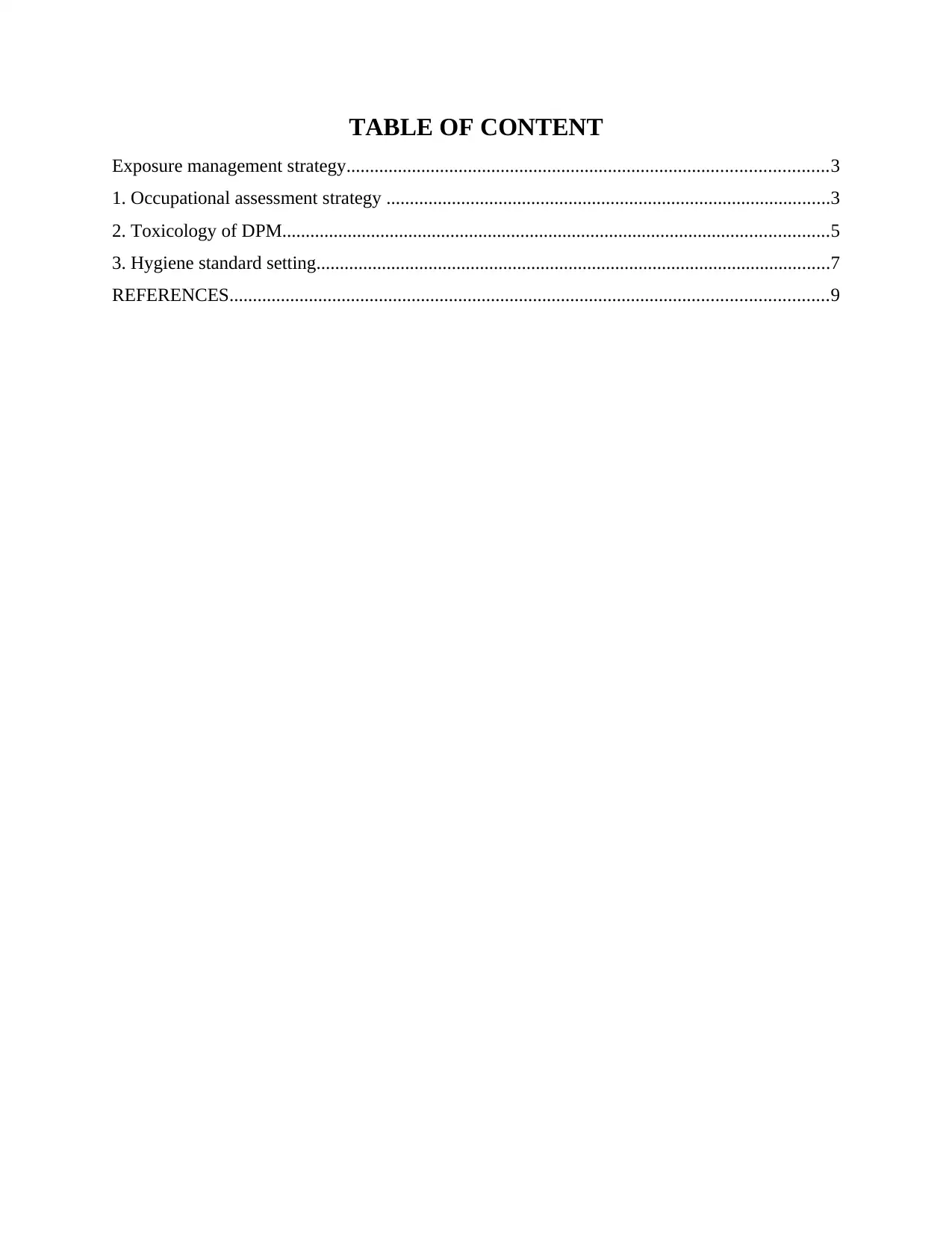
TABLE OF CONTENT
Exposure management strategy.......................................................................................................3
1. Occupational assessment strategy ...............................................................................................3
2. Toxicology of DPM.....................................................................................................................5
3. Hygiene standard setting..............................................................................................................7
REFERENCES................................................................................................................................9
Exposure management strategy.......................................................................................................3
1. Occupational assessment strategy ...............................................................................................3
2. Toxicology of DPM.....................................................................................................................5
3. Hygiene standard setting..............................................................................................................7
REFERENCES................................................................................................................................9
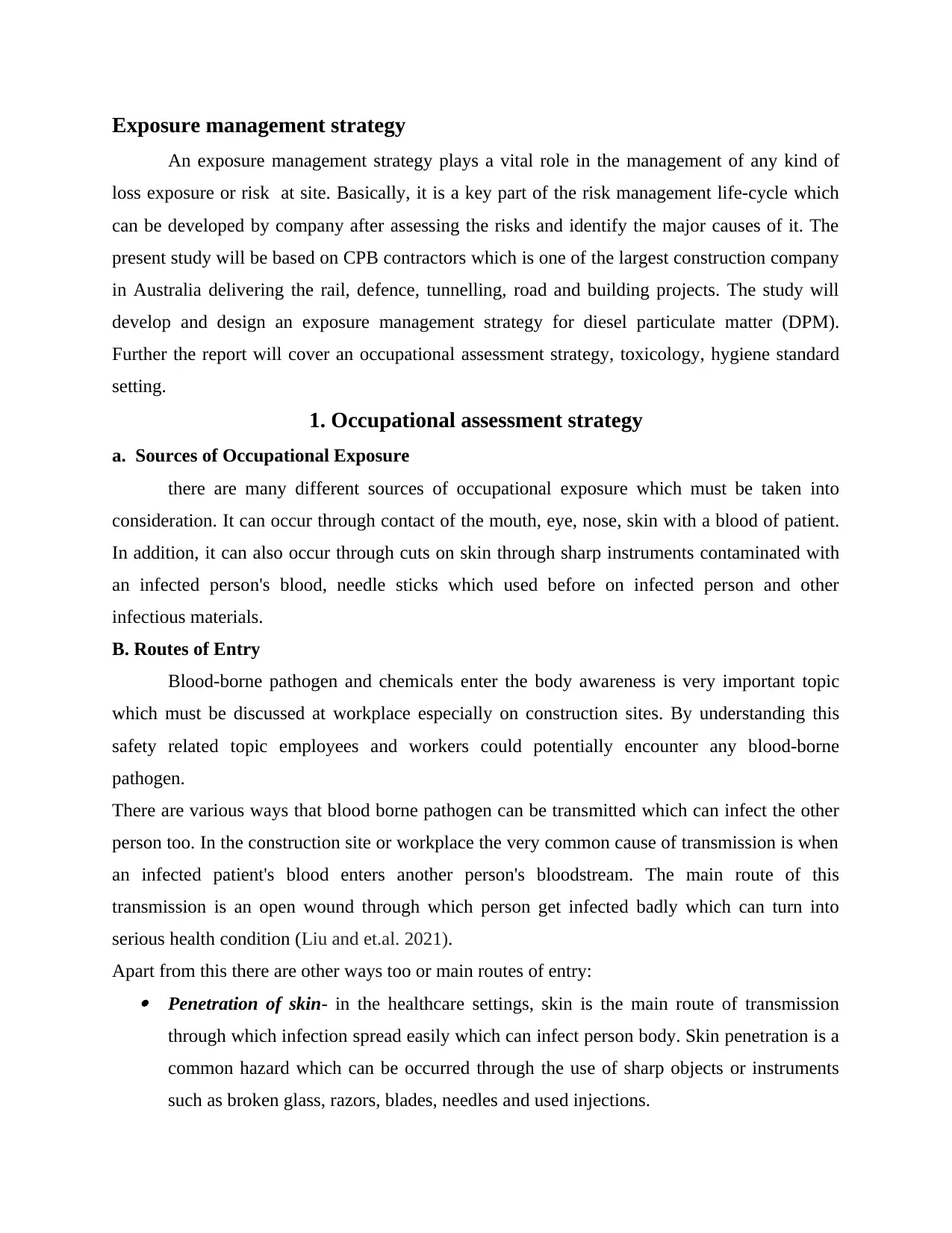
Exposure management strategy
An exposure management strategy plays a vital role in the management of any kind of
loss exposure or risk at site. Basically, it is a key part of the risk management life-cycle which
can be developed by company after assessing the risks and identify the major causes of it. The
present study will be based on CPB contractors which is one of the largest construction company
in Australia delivering the rail, defence, tunnelling, road and building projects. The study will
develop and design an exposure management strategy for diesel particulate matter (DPM).
Further the report will cover an occupational assessment strategy, toxicology, hygiene standard
setting.
1. Occupational assessment strategy
a. Sources of Occupational Exposure
there are many different sources of occupational exposure which must be taken into
consideration. It can occur through contact of the mouth, eye, nose, skin with a blood of patient.
In addition, it can also occur through cuts on skin through sharp instruments contaminated with
an infected person's blood, needle sticks which used before on infected person and other
infectious materials.
B. Routes of Entry
Blood-borne pathogen and chemicals enter the body awareness is very important topic
which must be discussed at workplace especially on construction sites. By understanding this
safety related topic employees and workers could potentially encounter any blood-borne
pathogen.
There are various ways that blood borne pathogen can be transmitted which can infect the other
person too. In the construction site or workplace the very common cause of transmission is when
an infected patient's blood enters another person's bloodstream. The main route of this
transmission is an open wound through which person get infected badly which can turn into
serious health condition (Liu and et.al. 2021).
Apart from this there are other ways too or main routes of entry: Penetration of skin- in the healthcare settings, skin is the main route of transmission
through which infection spread easily which can infect person body. Skin penetration is a
common hazard which can be occurred through the use of sharp objects or instruments
such as broken glass, razors, blades, needles and used injections.
An exposure management strategy plays a vital role in the management of any kind of
loss exposure or risk at site. Basically, it is a key part of the risk management life-cycle which
can be developed by company after assessing the risks and identify the major causes of it. The
present study will be based on CPB contractors which is one of the largest construction company
in Australia delivering the rail, defence, tunnelling, road and building projects. The study will
develop and design an exposure management strategy for diesel particulate matter (DPM).
Further the report will cover an occupational assessment strategy, toxicology, hygiene standard
setting.
1. Occupational assessment strategy
a. Sources of Occupational Exposure
there are many different sources of occupational exposure which must be taken into
consideration. It can occur through contact of the mouth, eye, nose, skin with a blood of patient.
In addition, it can also occur through cuts on skin through sharp instruments contaminated with
an infected person's blood, needle sticks which used before on infected person and other
infectious materials.
B. Routes of Entry
Blood-borne pathogen and chemicals enter the body awareness is very important topic
which must be discussed at workplace especially on construction sites. By understanding this
safety related topic employees and workers could potentially encounter any blood-borne
pathogen.
There are various ways that blood borne pathogen can be transmitted which can infect the other
person too. In the construction site or workplace the very common cause of transmission is when
an infected patient's blood enters another person's bloodstream. The main route of this
transmission is an open wound through which person get infected badly which can turn into
serious health condition (Liu and et.al. 2021).
Apart from this there are other ways too or main routes of entry: Penetration of skin- in the healthcare settings, skin is the main route of transmission
through which infection spread easily which can infect person body. Skin penetration is a
common hazard which can be occurred through the use of sharp objects or instruments
such as broken glass, razors, blades, needles and used injections.
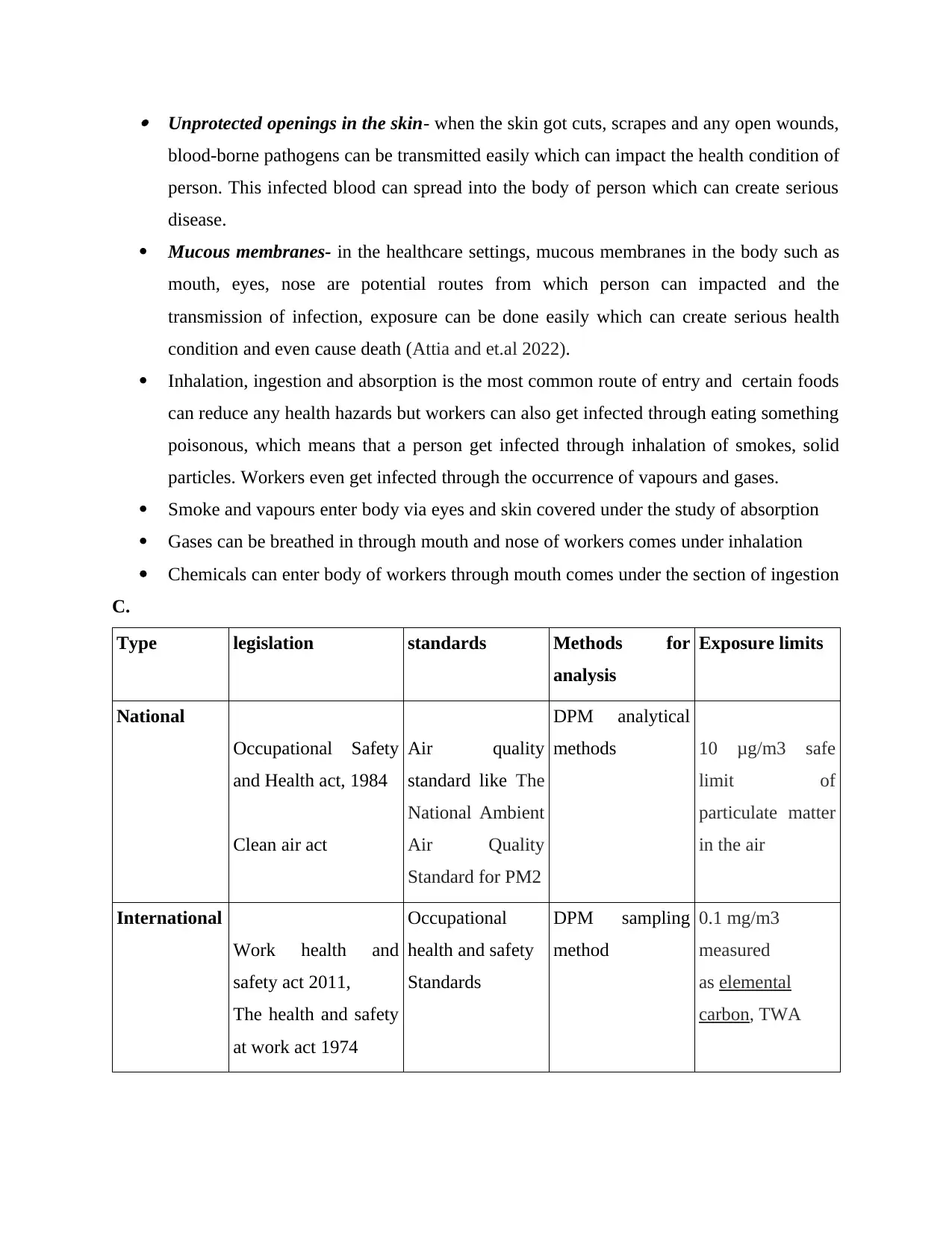
Unprotected openings in the skin- when the skin got cuts, scrapes and any open wounds,
blood-borne pathogens can be transmitted easily which can impact the health condition of
person. This infected blood can spread into the body of person which can create serious
disease.
Mucous membranes- in the healthcare settings, mucous membranes in the body such as
mouth, eyes, nose are potential routes from which person can impacted and the
transmission of infection, exposure can be done easily which can create serious health
condition and even cause death (Attia and et.al 2022).
Inhalation, ingestion and absorption is the most common route of entry and certain foods
can reduce any health hazards but workers can also get infected through eating something
poisonous, which means that a person get infected through inhalation of smokes, solid
particles. Workers even get infected through the occurrence of vapours and gases.
Smoke and vapours enter body via eyes and skin covered under the study of absorption
Gases can be breathed in through mouth and nose of workers comes under inhalation
Chemicals can enter body of workers through mouth comes under the section of ingestion
C.
Type legislation standards Methods for
analysis
Exposure limits
National
Occupational Safety
and Health act, 1984
Clean air act
Air quality
standard like The
National Ambient
Air Quality
Standard for PM2
DPM analytical
methods 10 μg/m3 safe
limit of
particulate matter
in the air
International
Work health and
safety act 2011,
The health and safety
at work act 1974
Occupational
health and safety
Standards
DPM sampling
method
0.1 mg/m3
measured
as elemental
carbon, TWA
blood-borne pathogens can be transmitted easily which can impact the health condition of
person. This infected blood can spread into the body of person which can create serious
disease.
Mucous membranes- in the healthcare settings, mucous membranes in the body such as
mouth, eyes, nose are potential routes from which person can impacted and the
transmission of infection, exposure can be done easily which can create serious health
condition and even cause death (Attia and et.al 2022).
Inhalation, ingestion and absorption is the most common route of entry and certain foods
can reduce any health hazards but workers can also get infected through eating something
poisonous, which means that a person get infected through inhalation of smokes, solid
particles. Workers even get infected through the occurrence of vapours and gases.
Smoke and vapours enter body via eyes and skin covered under the study of absorption
Gases can be breathed in through mouth and nose of workers comes under inhalation
Chemicals can enter body of workers through mouth comes under the section of ingestion
C.
Type legislation standards Methods for
analysis
Exposure limits
National
Occupational Safety
and Health act, 1984
Clean air act
Air quality
standard like The
National Ambient
Air Quality
Standard for PM2
DPM analytical
methods 10 μg/m3 safe
limit of
particulate matter
in the air
International
Work health and
safety act 2011,
The health and safety
at work act 1974
Occupational
health and safety
Standards
DPM sampling
method
0.1 mg/m3
measured
as elemental
carbon, TWA
Paraphrase This Document
Need a fresh take? Get an instant paraphrase of this document with our AI Paraphraser
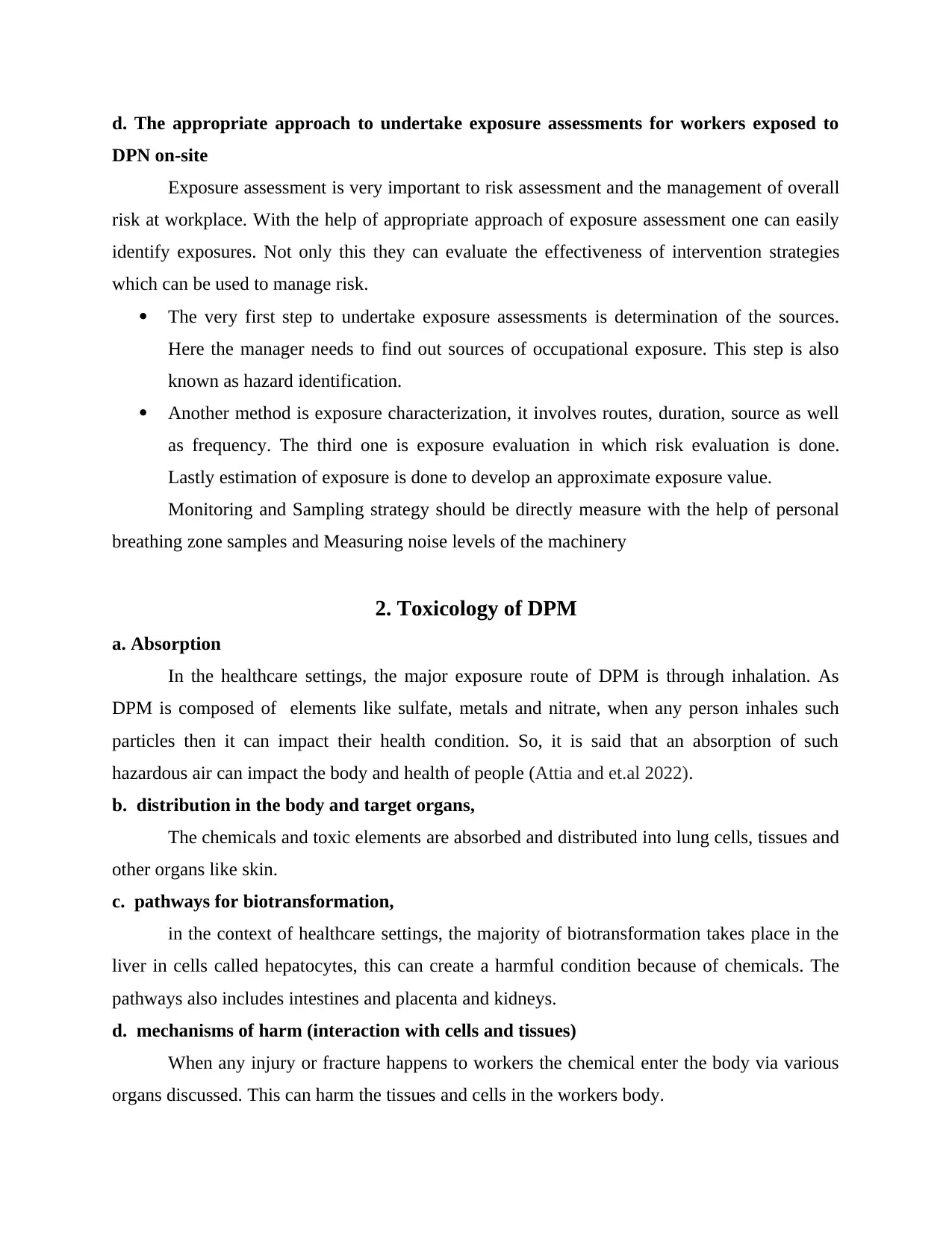
d. The appropriate approach to undertake exposure assessments for workers exposed to
DPN on-site
Exposure assessment is very important to risk assessment and the management of overall
risk at workplace. With the help of appropriate approach of exposure assessment one can easily
identify exposures. Not only this they can evaluate the effectiveness of intervention strategies
which can be used to manage risk.
The very first step to undertake exposure assessments is determination of the sources.
Here the manager needs to find out sources of occupational exposure. This step is also
known as hazard identification.
Another method is exposure characterization, it involves routes, duration, source as well
as frequency. The third one is exposure evaluation in which risk evaluation is done.
Lastly estimation of exposure is done to develop an approximate exposure value.
Monitoring and Sampling strategy should be directly measure with the help of personal
breathing zone samples and Measuring noise levels of the machinery
2. Toxicology of DPM
a. Absorption
In the healthcare settings, the major exposure route of DPM is through inhalation. As
DPM is composed of elements like sulfate, metals and nitrate, when any person inhales such
particles then it can impact their health condition. So, it is said that an absorption of such
hazardous air can impact the body and health of people (Attia and et.al 2022).
b. distribution in the body and target organs,
The chemicals and toxic elements are absorbed and distributed into lung cells, tissues and
other organs like skin.
c. pathways for biotransformation,
in the context of healthcare settings, the majority of biotransformation takes place in the
liver in cells called hepatocytes, this can create a harmful condition because of chemicals. The
pathways also includes intestines and placenta and kidneys.
d. mechanisms of harm (interaction with cells and tissues)
When any injury or fracture happens to workers the chemical enter the body via various
organs discussed. This can harm the tissues and cells in the workers body.
DPN on-site
Exposure assessment is very important to risk assessment and the management of overall
risk at workplace. With the help of appropriate approach of exposure assessment one can easily
identify exposures. Not only this they can evaluate the effectiveness of intervention strategies
which can be used to manage risk.
The very first step to undertake exposure assessments is determination of the sources.
Here the manager needs to find out sources of occupational exposure. This step is also
known as hazard identification.
Another method is exposure characterization, it involves routes, duration, source as well
as frequency. The third one is exposure evaluation in which risk evaluation is done.
Lastly estimation of exposure is done to develop an approximate exposure value.
Monitoring and Sampling strategy should be directly measure with the help of personal
breathing zone samples and Measuring noise levels of the machinery
2. Toxicology of DPM
a. Absorption
In the healthcare settings, the major exposure route of DPM is through inhalation. As
DPM is composed of elements like sulfate, metals and nitrate, when any person inhales such
particles then it can impact their health condition. So, it is said that an absorption of such
hazardous air can impact the body and health of people (Attia and et.al 2022).
b. distribution in the body and target organs,
The chemicals and toxic elements are absorbed and distributed into lung cells, tissues and
other organs like skin.
c. pathways for biotransformation,
in the context of healthcare settings, the majority of biotransformation takes place in the
liver in cells called hepatocytes, this can create a harmful condition because of chemicals. The
pathways also includes intestines and placenta and kidneys.
d. mechanisms of harm (interaction with cells and tissues)
When any injury or fracture happens to workers the chemical enter the body via various
organs discussed. This can harm the tissues and cells in the workers body.

e. pathways of elimination for DPM
Any chemicals, drugs, metabolites which is found out in the workers body are eliminated
largely by the kidneys in urine.
Any chemicals, drugs, metabolites which is found out in the workers body are eliminated
largely by the kidneys in urine.
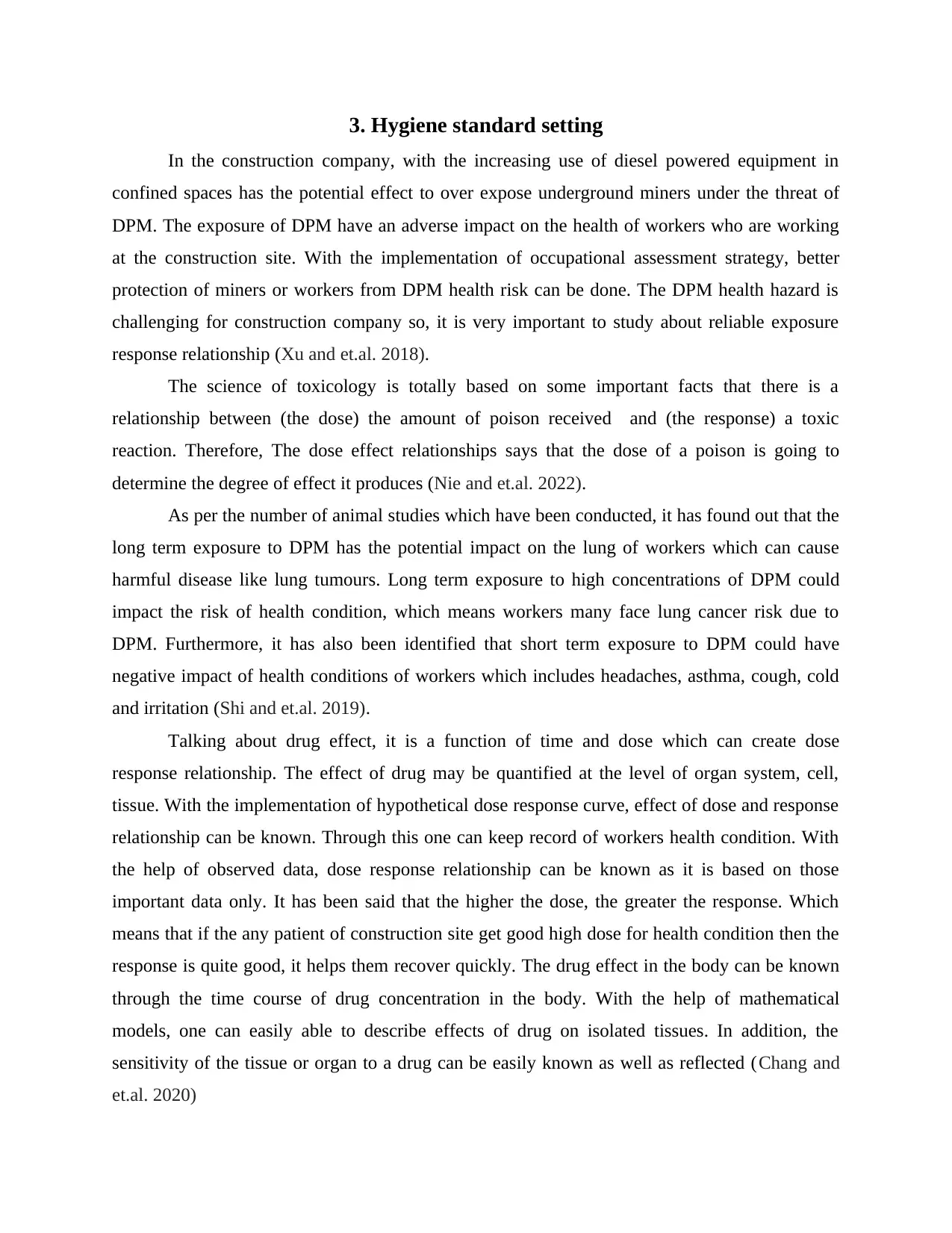
3. Hygiene standard setting
In the construction company, with the increasing use of diesel powered equipment in
confined spaces has the potential effect to over expose underground miners under the threat of
DPM. The exposure of DPM have an adverse impact on the health of workers who are working
at the construction site. With the implementation of occupational assessment strategy, better
protection of miners or workers from DPM health risk can be done. The DPM health hazard is
challenging for construction company so, it is very important to study about reliable exposure
response relationship (Xu and et.al. 2018).
The science of toxicology is totally based on some important facts that there is a
relationship between (the dose) the amount of poison received and (the response) a toxic
reaction. Therefore, The dose effect relationships says that the dose of a poison is going to
determine the degree of effect it produces (Nie and et.al. 2022).
As per the number of animal studies which have been conducted, it has found out that the
long term exposure to DPM has the potential impact on the lung of workers which can cause
harmful disease like lung tumours. Long term exposure to high concentrations of DPM could
impact the risk of health condition, which means workers many face lung cancer risk due to
DPM. Furthermore, it has also been identified that short term exposure to DPM could have
negative impact of health conditions of workers which includes headaches, asthma, cough, cold
and irritation (Shi and et.al. 2019).
Talking about drug effect, it is a function of time and dose which can create dose
response relationship. The effect of drug may be quantified at the level of organ system, cell,
tissue. With the implementation of hypothetical dose response curve, effect of dose and response
relationship can be known. Through this one can keep record of workers health condition. With
the help of observed data, dose response relationship can be known as it is based on those
important data only. It has been said that the higher the dose, the greater the response. Which
means that if the any patient of construction site get good high dose for health condition then the
response is quite good, it helps them recover quickly. The drug effect in the body can be known
through the time course of drug concentration in the body. With the help of mathematical
models, one can easily able to describe effects of drug on isolated tissues. In addition, the
sensitivity of the tissue or organ to a drug can be easily known as well as reflected (Chang and
et.al. 2020)
In the construction company, with the increasing use of diesel powered equipment in
confined spaces has the potential effect to over expose underground miners under the threat of
DPM. The exposure of DPM have an adverse impact on the health of workers who are working
at the construction site. With the implementation of occupational assessment strategy, better
protection of miners or workers from DPM health risk can be done. The DPM health hazard is
challenging for construction company so, it is very important to study about reliable exposure
response relationship (Xu and et.al. 2018).
The science of toxicology is totally based on some important facts that there is a
relationship between (the dose) the amount of poison received and (the response) a toxic
reaction. Therefore, The dose effect relationships says that the dose of a poison is going to
determine the degree of effect it produces (Nie and et.al. 2022).
As per the number of animal studies which have been conducted, it has found out that the
long term exposure to DPM has the potential impact on the lung of workers which can cause
harmful disease like lung tumours. Long term exposure to high concentrations of DPM could
impact the risk of health condition, which means workers many face lung cancer risk due to
DPM. Furthermore, it has also been identified that short term exposure to DPM could have
negative impact of health conditions of workers which includes headaches, asthma, cough, cold
and irritation (Shi and et.al. 2019).
Talking about drug effect, it is a function of time and dose which can create dose
response relationship. The effect of drug may be quantified at the level of organ system, cell,
tissue. With the implementation of hypothetical dose response curve, effect of dose and response
relationship can be known. Through this one can keep record of workers health condition. With
the help of observed data, dose response relationship can be known as it is based on those
important data only. It has been said that the higher the dose, the greater the response. Which
means that if the any patient of construction site get good high dose for health condition then the
response is quite good, it helps them recover quickly. The drug effect in the body can be known
through the time course of drug concentration in the body. With the help of mathematical
models, one can easily able to describe effects of drug on isolated tissues. In addition, the
sensitivity of the tissue or organ to a drug can be easily known as well as reflected (Chang and
et.al. 2020)
Secure Best Marks with AI Grader
Need help grading? Try our AI Grader for instant feedback on your assignments.
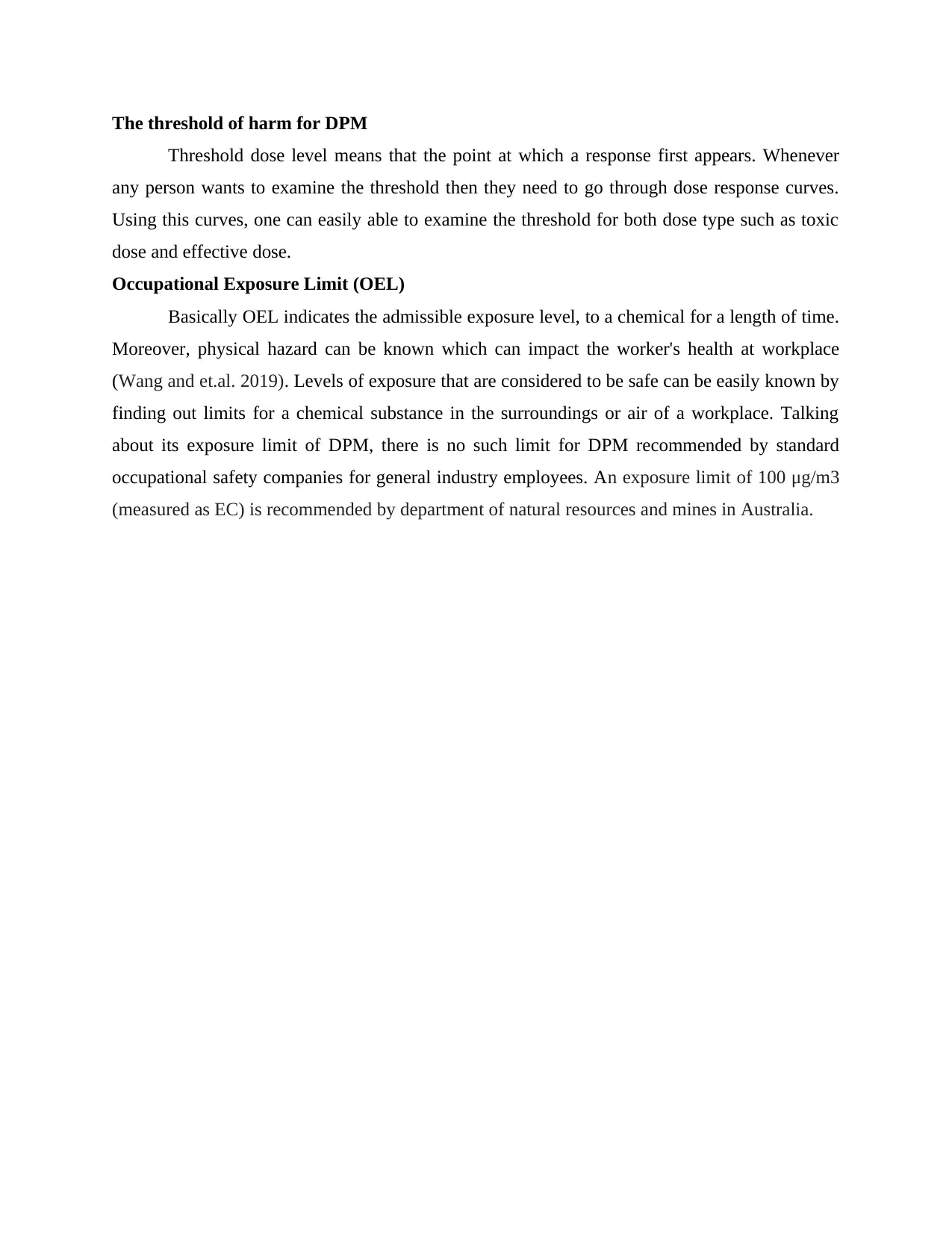
The threshold of harm for DPM
Threshold dose level means that the point at which a response first appears. Whenever
any person wants to examine the threshold then they need to go through dose response curves.
Using this curves, one can easily able to examine the threshold for both dose type such as toxic
dose and effective dose.
Occupational Exposure Limit (OEL)
Basically OEL indicates the admissible exposure level, to a chemical for a length of time.
Moreover, physical hazard can be known which can impact the worker's health at workplace
(Wang and et.al. 2019). Levels of exposure that are considered to be safe can be easily known by
finding out limits for a chemical substance in the surroundings or air of a workplace. Talking
about its exposure limit of DPM, there is no such limit for DPM recommended by standard
occupational safety companies for general industry employees. An exposure limit of 100 μg/m3
(measured as EC) is recommended by department of natural resources and mines in Australia.
Threshold dose level means that the point at which a response first appears. Whenever
any person wants to examine the threshold then they need to go through dose response curves.
Using this curves, one can easily able to examine the threshold for both dose type such as toxic
dose and effective dose.
Occupational Exposure Limit (OEL)
Basically OEL indicates the admissible exposure level, to a chemical for a length of time.
Moreover, physical hazard can be known which can impact the worker's health at workplace
(Wang and et.al. 2019). Levels of exposure that are considered to be safe can be easily known by
finding out limits for a chemical substance in the surroundings or air of a workplace. Talking
about its exposure limit of DPM, there is no such limit for DPM recommended by standard
occupational safety companies for general industry employees. An exposure limit of 100 μg/m3
(measured as EC) is recommended by department of natural resources and mines in Australia.
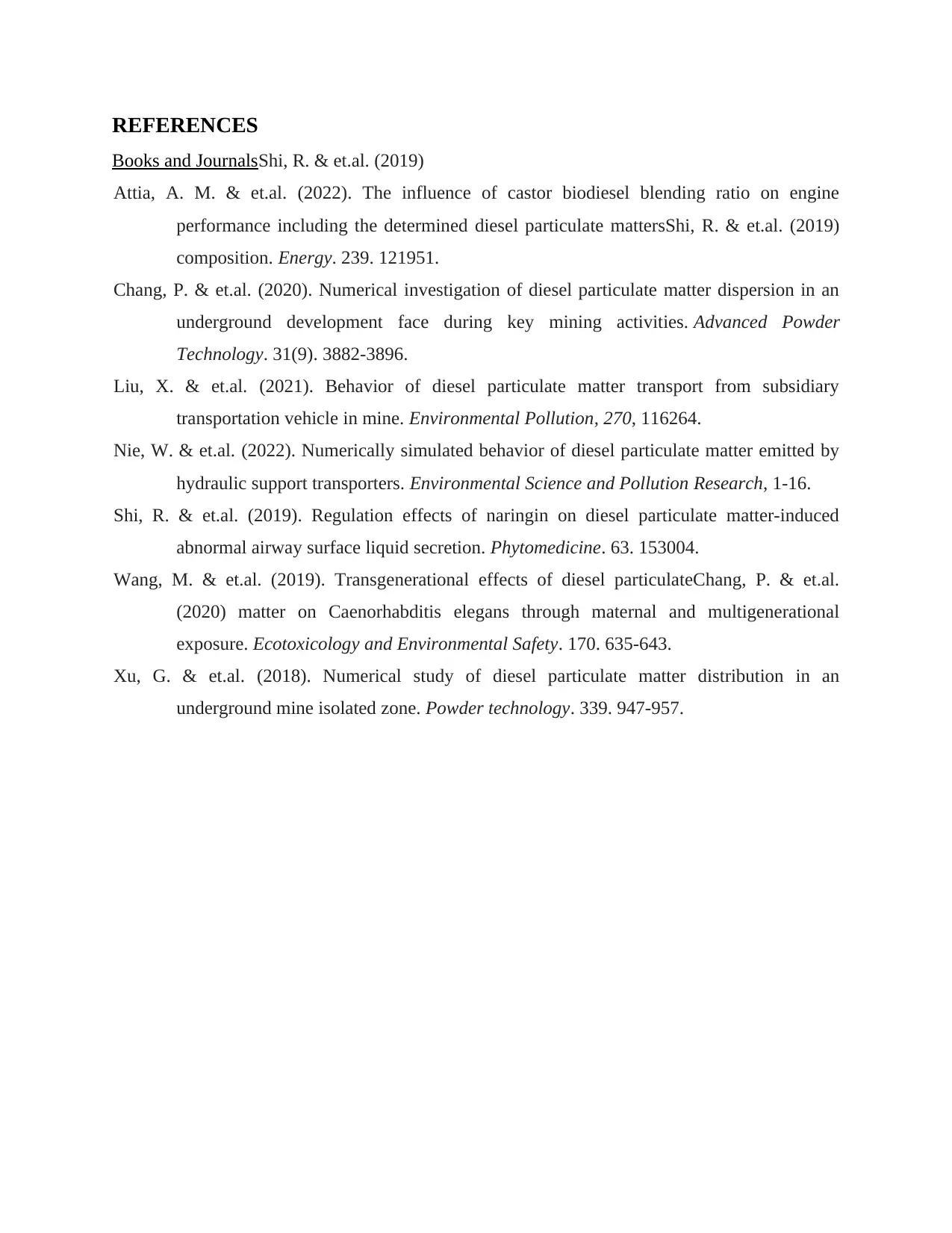
REFERENCES
Books and JournalsShi, R. & et.al. (2019)
Attia, A. M. & et.al. (2022). The influence of castor biodiesel blending ratio on engine
performance including the determined diesel particulate mattersShi, R. & et.al. (2019)
composition. Energy. 239. 121951.
Chang, P. & et.al. (2020). Numerical investigation of diesel particulate matter dispersion in an
underground development face during key mining activities. Advanced Powder
Technology. 31(9). 3882-3896.
Liu, X. & et.al. (2021). Behavior of diesel particulate matter transport from subsidiary
transportation vehicle in mine. Environmental Pollution, 270, 116264.
Nie, W. & et.al. (2022). Numerically simulated behavior of diesel particulate matter emitted by
hydraulic support transporters. Environmental Science and Pollution Research, 1-16.
Shi, R. & et.al. (2019). Regulation effects of naringin on diesel particulate matter-induced
abnormal airway surface liquid secretion. Phytomedicine. 63. 153004.
Wang, M. & et.al. (2019). Transgenerational effects of diesel particulateChang, P. & et.al.
(2020) matter on Caenorhabditis elegans through maternal and multigenerational
exposure. Ecotoxicology and Environmental Safety. 170. 635-643.
Xu, G. & et.al. (2018). Numerical study of diesel particulate matter distribution in an
underground mine isolated zone. Powder technology. 339. 947-957.
Books and JournalsShi, R. & et.al. (2019)
Attia, A. M. & et.al. (2022). The influence of castor biodiesel blending ratio on engine
performance including the determined diesel particulate mattersShi, R. & et.al. (2019)
composition. Energy. 239. 121951.
Chang, P. & et.al. (2020). Numerical investigation of diesel particulate matter dispersion in an
underground development face during key mining activities. Advanced Powder
Technology. 31(9). 3882-3896.
Liu, X. & et.al. (2021). Behavior of diesel particulate matter transport from subsidiary
transportation vehicle in mine. Environmental Pollution, 270, 116264.
Nie, W. & et.al. (2022). Numerically simulated behavior of diesel particulate matter emitted by
hydraulic support transporters. Environmental Science and Pollution Research, 1-16.
Shi, R. & et.al. (2019). Regulation effects of naringin on diesel particulate matter-induced
abnormal airway surface liquid secretion. Phytomedicine. 63. 153004.
Wang, M. & et.al. (2019). Transgenerational effects of diesel particulateChang, P. & et.al.
(2020) matter on Caenorhabditis elegans through maternal and multigenerational
exposure. Ecotoxicology and Environmental Safety. 170. 635-643.
Xu, G. & et.al. (2018). Numerical study of diesel particulate matter distribution in an
underground mine isolated zone. Powder technology. 339. 947-957.
1 out of 9
![[object Object]](/_next/static/media/star-bottom.7253800d.svg)





